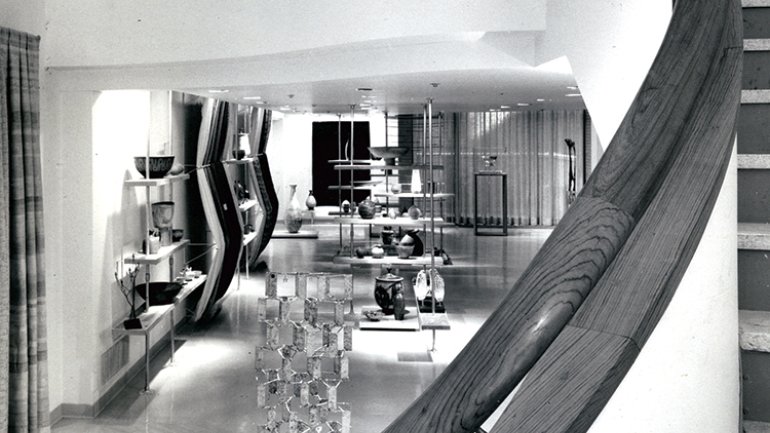Opening Night
Opening Night
On the evening of September 20, 1956, the doors of a renovated brownstone on New York’s West 53rd Street were unlocked: The American Craft Council’s new Museum of Contemporary Crafts had opened to the public.
The staff of the museum, a predecessor of today’s Museum of Arts and Design, had given their all to prepare. In her autobiography, ACC founder Aileen Osborn Webb recalls their effort: “I arrived [an hour before opening] at 7:00 to find director Tom Tibbs exhausted, saying that all he was good for was to push a broom around.”
What compelled them? Why did the ACC, an organization established in the early 1940s with an educational mission, put so much energy into founding a museum?
The American Craft Council (known then as the American Craftsmen’s Educational Council) already had a venue to promote artists. Its retail outlet a few blocks away, America House, featured a rotating selection of work by makers from across the country. The group also had a foot in formal education, as founders of the School for American Craftsmen (today the School for American Crafts at the Rochester Institute of Technology). The museum offered the organization something different – and timely.
The post-World War II era was a time of great growth and change in the United States. Industrial design and mass-produced products enjoyed rising popularity among the public at large; at the same time, an increasing focus on “the original” sought to celebrate work wrought by the hand of the individual craftsperson. The MCC was a place to explore that atmosphere of creative dichotomy, a venue for its emerging trailblazers. Organized by Tibbs, the debut exhibition, “Craftsmanship in a Changing World,” confronted this cultural tension head-on, featuring the work of craftspeople who were blurring the boundaries between art, design, and craft.
The MCC would go on not only to mount innovative exhibitions, but also to develop fresh educational programming for a new kind of visitor experience. When Paul J. Smith, a member of the ACC’s education staff, was appointed MCC director in 1963, that educational element assumed a greater role in the galleries. “We were creating shows that were imaginative, and perhaps not as formal for a museum, but reached people and new audiences,” Smith says.
One of Smith’s early exhibitions, “Amusements Is” featured a plethora of fun, humorous, and fantastical objects – and permission to participate, to play. The museum became “a total educational zone,” as Smith recalled in a Bard College oral history project. Such direct audience engagement upended the traditional museum edict – “Do not touch” – and visitors couldn’t get enough.
Smith, who remained director through 1987, still marvels at the memory: “The success of that show – and the fact that I wasn’t fired, that I got away with it . . . ”
Even as the museum provided new opportunities for makers and audiences, it was also opening up new possibilities for the American Craft Council. Establishing a museum lent weight and authority to the still-young organization. With its emphasis on “the new,” on what was current in the field, the MCC – and in turn, the ACC – quickly gained a reputation as the voice of contemporary American craft.
“Reporting on ‘the new’ wasn’t a tightly orchestrated or policed policy,” explains Smith, “but it was very much part of the idea for the museum.” The museum had a modest permanent collection; its primary emphasis was as a venue for innovative, emerging work from across the nation. At the time, “the studio craft movement was growing so rapidly, and so much was happening, ” Smith says.
The brownstone on West 53rd no longer houses the museum. Over the decades, the institution moved to progressively larger buildings and changed its name twice – first to the American Craft Museum (which in 1990 became an independent entity) and, in 2002, to the Museum of Arts and Design, or MAD. But that drive to reflect the new, to serve as the leading champion for contemporary craft, is something the museum and the ACC have never lost.
Browse catalogues, photographs, and other documents from the Museum of Contemporary Crafts, courtesy of the ACC Library’s Digital Archives. Rachel Kirchgasler is ACC education coordinator.

